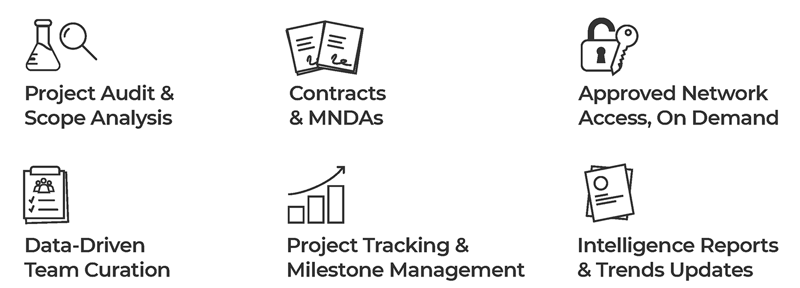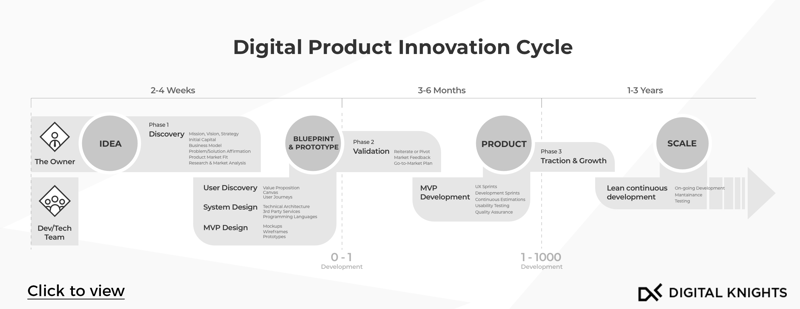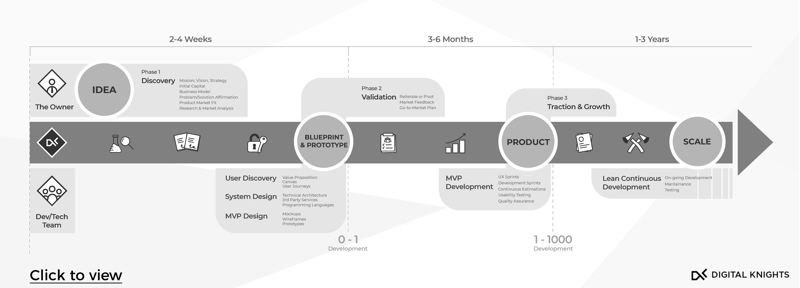How successful CIOs navigate the Innovation Process
INNOVATION | 24 Nov 2017
‘Innovation is the process of pushing a new concept toward its implementation in the society with the objective of creating value. Uncertainty is the key unavoidable aspect of innovation.’ – Innovation Intelligence (2015)
Innovation, by nature, is risky business. The costs of getting innovation wrong and the resulting failure are well-documented by the countless tales of time lost and money wasted. So why does this continue to be an issue for entrepreneurs and corporations alike? What is missing that causes history to repeat itself, keeping good ideas from breaking through?
The biggest cause of innovation project failure
According to the elite software development companies in the Digital Knights network of approved tech teams, projects fail for a variety of different reasons, yet they all fall under one common theme: There is a fundamental misunderstanding and/or disregard of the innovation process.
Regardless of how stressful or time-sensitive the situation for product development may be, the innovation cycle doesn’t change. Each step requires proper attention for things to work; it doesn’t matter if there’s a first-time innovator or a serial entrepreneur behind the scenes, disrespecting the process and cutting corners will always incur consequences down the road.
The digital innovation cycle for product development
The innovation process can be broken down into three phases of differing durations and comparable importance: Discovery, Validation, and Traction & Growth.
‘The Cycle can be thought of both as a sequence, moving from one of the segments clockwise through to the next, or as standalone segments that apply a focus to the collaboration efforts of members.’ – European Alliance for Innovation
Phase 1 – Discovery
Getting ready to build a product
This ideation stage covers all the market research, business planning, and product details necessary for developing a prototype or blueprint that provides a clear picture from start to finish. There is no sense in taking any action beyond brainstorming until there is a product idea with proper market validation and a viable business model. Successful products must solve real problems, and they must provide solutions that people will actually use. The existing market for the product must also be big enough to accommodate a new player, or the product must be significantly more appealing and useful than what’s already out there. Once all the proper planning is in place, the last prerequisite is to round up the initial resources or capital to build what’s necessary to get from phase one to phase two.
These initial steps lay the foundation for successful product development and it’s crucial that they are well-thought out. This phase doesn’t need to take more than 2-4 weeks, but it can make the difference between a year-long project’s success or its failure.
Phase 2 – Validation
Getting a product ready for market
Phase two is all about building upon that first blueprint or prototype developed in phase one. It entails hands-on work that focuses on iterating and pivoting in development sprints based on initial market feedback and learnings from the first rounds of tests. This is the phase where huge amounts of manpower are needed, the go-to-market plan is implemented, and the MVP takes shape. The development team will be heavily involved with back and forth movements until the first version of the product is ready for launch.
This phase can take anywhere from 3-6 months (or more) depending on how many pivots or iterations occur. If phase one is done exceptionally well, however, these are kept to a minimum. It’s very important not to rush through this phase because poor decisions will result in lost time and traction. After all, the product that reaches market needs to be functional and convincing in its most rudimentary sense–and still get there quickly. Later on, development of the wishlist of features desired by the wider stakeholder group will get started as the product evolves from phase two to phase three.
Phase 3 – Traction and Growth
Getting ready to scale up
This phase is where scaling happens. The growth cycle can take from one to three years and is all about reaching a point where the product needs only lean, continuous development and maintenance. The MVP will have established a solid codebase and presence in the market, and so it is simply a matter of making small tweaks, improvements, and building new features on the fly. Given there is no limit to the amendments, testing, and features that can be added during this phase, it often extends out past the 3 year mark as long as growth rates are still high. When the product maxes out its growth potential, it’s time to venture out with another idea back at phase one.
How a technical partner fits in
While the business development side of things is critical for developing the theory, it must be put into practice somehow. This means taking the steps to decide who will execute the plan and how. After deciding between risking software development with a pool of freelance coders, recruiting in-house engineers, or partnering with existing tech teams, it’s important to have a shared understanding of the innovation process before getting started.
Phase 1
A good development team has full product lifecycle and industry specific experience to be a strategic partner right from the beginning of the discovery phase. This team will act as an advisor, asking the right questions and suggesting solutions throughout the brainstorming process. Once the idea for the product is deemed viable and complete, it’s critical that the whole team can nail down the proper infrastructure and technical architecture required to develop the product so that it offers the best solution possible. Experienced partners will identify different – and in some cases better – ways to solve the problem than the original proposal. As the appropriate tech stacks and architecture are identified, the wireframes, user journeys, prototypes and mockups can be developed.
Phase 2
The development team is heavily involved in the validation phase of the innovation process, as nothing moves forward without the real, raw development. The hard work really kicks in here with the team implementing UX and dev sprints, usability testing, and quality assurance to ensure the first iterations are not only functional, but available for test in the market. The resulting minimum viable product is the most telling factor as to whether this product will be convincing to the end-user, gain attention in the market, and even attract investment.
Phase 3
The final phase is where the product is improved based on user testing feedback and where development of additional features can begin. As this phase progresses, the development team usually becomes leaner. The majority of the legwork is done and it is now a matter of maintaining and developing the additional features until the minimum viable product reaches its greatest potential.
The Digital Knights Advantage
Getting the innovation cycle started with an experienced, highly talented technical partner is key for developing with speed, confidence, and most of all, successful end results. Tech teams within the Digital Knights approved network are verified for all phases of the product development, and Digital Knights provides several services and benefits to guide and accelerate innovation throughout the entire process.
These include:

To learn how Digital Knights curates teams for a given project, read The must-haves to consider when choosing a tech partner for more information.

